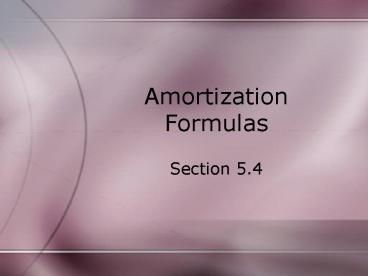Amortization Formulas - PowerPoint PPT Presentation
1 / 13
Title:
Amortization Formulas
Description:
Amortization Formulas. Section 5.4. Periodic Payment ... beginning of any period by filling out an amortization table up to that point. ... – PowerPoint PPT presentation
Number of Views:51
Avg rating:3.0/5.0
Title: Amortization Formulas
1
Amortization Formulas
- Section 5.4
2
Periodic Payment
- A loan is essentially a loan purchased by the
lending institution in which the borrower agrees
to make regular periodic payments. - So to find the payment amount for a loan we can
use the formula to find the payment for an
annuity
3
Periodic Payment, example
- Find the monthly payment for a 7200 loan at
10.2 annual interest compounded monthly to be
repaid over 4 years. - We can use the formula with A 7200, n 412,
and r .102/12.
4
Outstanding Principal
- We can always find the outstanding principal
remaining at the beginning of any period by
filling out an amortization table up to that
point. - But suppose we want to find the principal due at
the beginning of the 20th period, that can take a
lot of work. - So well try to find an easier way of computing
this.
5
- Lets look back at the time value equation of the
loan. - The amount of the loan is equal to the present
value of all the payments.
A
R(1r)-1
R(1r)-2
R(1r)-3
R(1r)-(n-2)
R(1r)-(n-1)
R(1r)-n
So A R(1r)-1 R(1r)-2 R(1r)-3 . . .
R(1r)-(n-2) R(1r)-(n-1) R(1r)-n
6
- Now lets look at this equation at the beginning
of the kth period.
A
A(1r)k-1
R
R(1r)1
R(1r)k-3
R(1r)k-2
R(1r)-1
R(1r)-(n-k)
R(1r)-(n-k1)
The values in red are the present values of the
payments yet to be made.
The sum of these gives us the principal at the
beginning of the kth payment period.
7
- But this is just the present value of an ordinary
annuity. - We had n payments and have already made k - 1, so
we have n - (k - 1) n - k 1 payments left. - So we end up with the following formula for the
outstanding principal at the beginning of the kth
payment period
8
Outstanding Principal, example
- Find the outstanding principal at the beginning
of the 16th year of a 30-year, 200,000 home loan
at 6.24 compounded monthly with monthly
payments. - First we need to find the monthly payment.
- A 200,000, n 3012, r .0624/12
- Using k 1512 1, (so n - (k - 1) 180) we
get
9
Interest and Principal in kth payment
- Now that we can find the balance at the beginning
of any period, it is easy to find the interest
and principal in any payment. - To find the interest in any payment we multiply
the outstanding balance by the periodic interest
rate r. - So the interest in the kth payment is given by
- To get the principal in the kth payment we simply
subtract the interest from the payment amount
10
Interest and Principal in kth payment
- Find the interest and principal paid in the
payment at the beginning of the 16th year for the
loan above. - We have R 1230.13 (R 1230.13393), so
11
Total Interest Paid
- We have one last formula, the total interest paid
during the term of a loan. - We get this by subtracting the amount of the loan
from the total amount paid out. - This is simply nR - A.
12
- Jared takes out a 6-year loan to purchase a
17,000 car. If the interest on the loan is 9.3
compounded monthly, find - The monthly payment.
- The outstanding balance at the beginning of the
5th year. - The interest in the first payment of the 5th
year. - The principal in the first payment of the 5th
year. - a)
- b)
- c) Multiply the answer in b) by .00775 I49
6742.79(.00775) 52.26 - d) Subtract the answer in c) from the payment
P49 308.97 - 52.26 256.71
13
Key Suggested Problems
- Sec. 5.4 12, 13, 16, 22
- Final exam, Monday, March 13, 530-718 pm
- Mills - UH 014
- Nikolov - MQ 264































